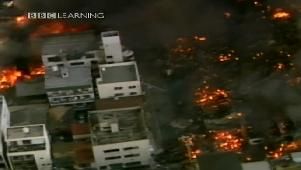Horizon
Earthquake Storms (2003x8)
: 06, 2003
Earthquakes are among the most devastating natural disasters on the planet. In the last hundred years they have claimed the lives of over one million people. Earthquakes are destructive mainly because of their unpredictable nature. It is impossible to say accurately when a quake will strike but a new theory could help save lives by preparing cities long in advance for an earthquake.
The surface of the Earth is made up of large 'tectonic' plates. These plates are in slow but constant motion. When two plates push against each other friction generates a great deal of energy. For this reason earthquakes occur most frequently on tectonic fault lines, where two plates meet. However these fault lines run for thousands of kilometres; predicting exactly where a quake will occur is nearly impossible.
In 1992, Dr Ross Stein was monitoring a large earthquake in a town in California called Landers. Three hours later, there was another quake 67km away at Great Bear. Stein believed that this was not simply an aftershock, instead he theorised the event at Landers had set off the earthquake at Big Bear. Stein believes that when an earthquake occurs the stress that has built up along the fault, is in part, transferred along the fault line. It is this energy transfer that causes other quakes to occur hours, days or months after the original.
